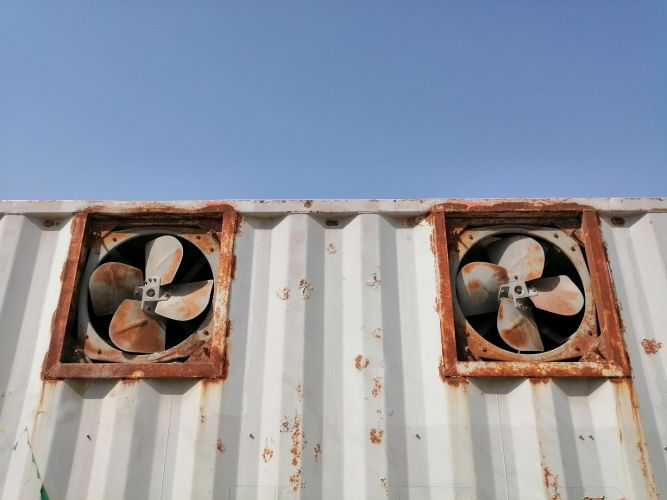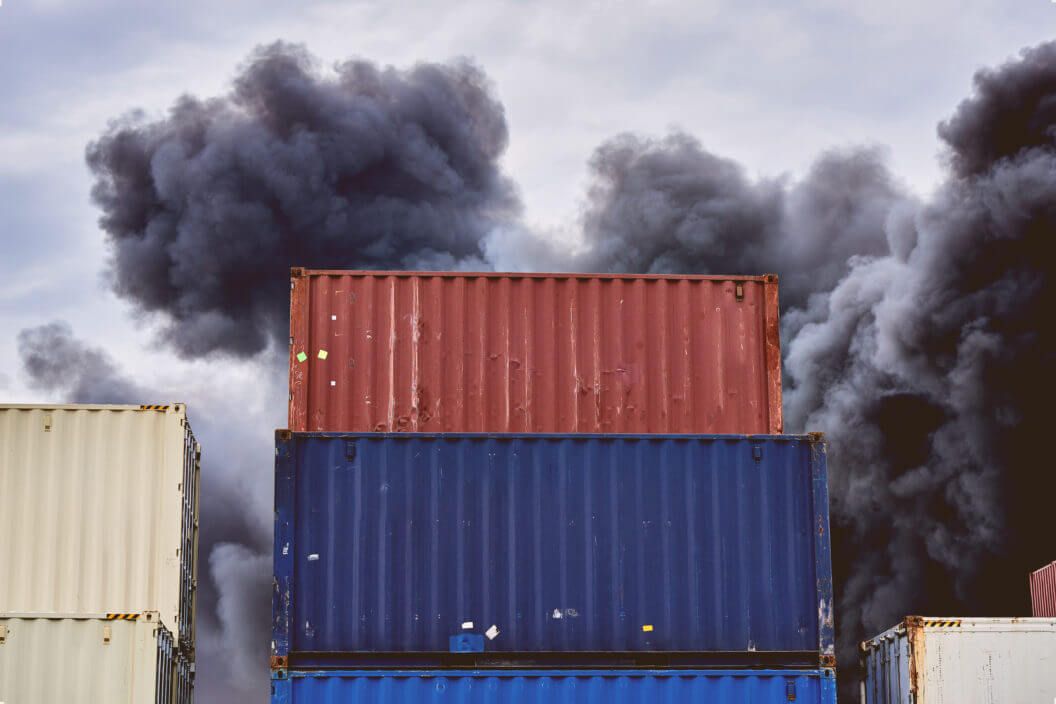- Rent, Lease, or Purchase
- |
March 20, 2021
Do Shipping Containers Need Ventilation?


Vents are crucial in shipping containers, especially if you are looking to build your own container home or use containers to store perishables or expensive equipment.
Without shipping container vents, moisture-sensitive and perishable goods that you store in it can rot away due to lack of proper circulation.
The airtight design of containers can pose a problem for private service due to lack of flow. That’s why a proper ventilation system is vital for a containerized home, storage space, and office.
Types of Ventilation Systems for Containers
There are two common types of ventilation units: passive ventilation and mechanical ventilation.
Passive Ventilation
Passive ventilation allows you to modify your container home or office without any external equipment or systems to maintain ideal temperatures. Placing vents on opposite sides allows air to blow in and out of your containers.
You can also ventilate your storage unit by making design modifications to utilize the wind flow through the unit. Strategically placing the windows on your walls' sides allow better circulation through the unit to remove stale air.
Examples include using ridge vents, creating provision for windows, and installing the container at an appropriate wind location.
Mechanical Ventilation
Passive ventilation can be insufficient if your unit is in a hot and humid region. Mechanical ventilation can help in such cases. Mechanical ventilation comes in three categories:
- Exhaust-only systems: These systems are simple and inexpensive to install and are well-suited for colder climates. Supply-only systems: These systems suck fresh air into your storage unit, container home, or office. Supply-only systems offer better control over the air supply. They also minimize the entry of dust and other pollutants to a large extent.
- Balanced systems: These systems do not alter the pressure inside and help maintain optimum pressure. Since they involve a combination of supply and exhaust, they help prevent the entry of dust and pollen. Balanced systems are appropriate for all types of climates.
- Roof Turbine Vents: Rooftop turbine vents, also known as extractor fans, are an exhaust-only system that can help you move the fumes inside the unit, up and out to remove humidity, heat, and smoke.
- Along with mechanical ventilation, you can also use these accessories in your shipping container:
- Dehumidifiers: A dehumidifier reduces the water content in the air and slows down the condensation of water, which can otherwise corrode the wall and plumbing points.
- Air filters: Air filters prevent the entry of dust and pollutants into the unit.
- Pro tip: Before you install any system, you must provide adequate insulation and protection to prevent heat losses. This applies especially to climate control or HVAC units.
Side Vents vs. Roof Vents: Which is Better for Container Ventilation?

Side vents and roof vents serve different purposes, so you need to choose based on your budget and application.
Louver vents or side vents are cheaper and easier to install. Place side vents in a diagonal position (one high and the other low) for cross-ventilation. Side vents also do not interfere much with the design of the unit. If your shipping container requires a large amount of ventilation, install multiple vents.
A turbine or rooftop vent can extract a high volume of stale air. It also disperses moisture faster. Installing a rooftop vent can be complex and requires professional help. Most people use both side and roof vents in containers for effective ventilation.
What Problems Can Poor Ventilation Cause in Containers?
Poor ventilation can severely affect the quality of goods you store and the health of the people living inside. Some common problems that a shipping container can face are:
Mold
Mold is a common issue in damp, moist environments. Lack of airflow can cause the accumulation of moisture and create the ideal conditions for this fungus to grow. Not only is mold difficult and expensive to remove, but its fumes can also have harmful effects on people.
Rust

Steel and other metal parts in your unit can rapidly corrode in the presence of moisture. This can severely affect your plumbing system and other pipelines and lead to high repair costs.
Bad Odors
Poor ventilation can lead to excessive moisture buildup, which can create musty odors in the container. Old rooms with a lack of cross-ventilation typically build up any lingering odor and emit a foul smell.
Diseases
Lack of circulation can lead to pneumonia, dry eyes, and nausea. Poor ventilation is also connected to common respiratory diseases like asthma.
When Do You Need Shipping Container Vents?

If you plan on using the shipping container only for storing items or equipment that are not sensitive to temperature changes, the existing vents may work fine. Remember that a basic container vent only allows a minimal amount of airflow inside. You can store lawnmowers, athletic equipment, and similar items in these conditions.
You might have to modify your outlets and intake vents to use units as storage space for perishable items or chemicals that are susceptible to explosion or fire.
You can make such modifications when you buy shipping containers - rental plans usually allow only minimal changes to the unit.
What Items Require Ventilation for Storage?
- Household items - Use ventilation to protect items that heat or moisture can damage easily during moves, donation drives, or remodels.
- Heavy machinery and vehicles - Use moderate temperatures and good air circulation to avoid repair to machinery and automobiles.
- Dry goods - Condensation can cause dry goods to rot. A well-ventilated unit can keep your good dry and cool.
- Chemicals and pressurized gases - These items must meet temperature and storage regulations. You'll need to check the laws and with your container provider.
How to Install Roof Vents on Shipping Containers
If you plan on installing the vents yourself, do your research and pay special attention to safety. Ensure that you have the right safety equipment such as glasses, gloves, earplugs, and safety shoes in place before you start working.
Check out this video for more info.
Should You DIY or Hire a Professional to Install Container Vents?
Go DIY if you have experience modifying containers and understand the vent installation process well. Ideally, you should hire a professional or consult an expert before installing rooftop vents.
How to Determine Vent Quantity for Your Container
Experts use various factors such as weather changes, wind speed, air movement and direction, and average surrounding temperature to identify the cause of condensation.
You can start by determining the wind speed and direction and then place your inlet vent and exhaust vent accordingly. A common rule of thumb is that exhaust vents can draw 4 cubic ft. / min /1 mph of wind. One unit is sufficient for slow wind speeds. Higher wind speed requires more vents.
This table gives a general idea of the number of exhaust vents and air exchange rates for different container sizes.

Note: These values will change with the type of vents you are installing.
Coating your containers with light color paints or adding insulation can be a simple yet effective way to maintain optimum temperatures.
Shipping containers that function as homes, offices, and storage units need adequate air circulation to maintain the ideal temperature, airflow, and humidity. Ensure the right number and types of container vents to prevent damage to your stuff. Seeking expert advice can help you make an informed decision.
How can we help?
At Mobile Modular Portable Storage, we focus on creating solutions that suit versatile needs. Our team of dedicated delivery and sales specialists pays keen attention to your requirements and ensures that you get containers for rent and sale at competitive prices with unparalleled service.
Our shipping container offices have HVAC units, lights, data lines, phones (pre-stubbed), and other on-demand accessories for your convenience.
Call us at 866-459-7600 to learn more about container ventilation.
Frequently Asked Questions
How do you ventilate a shipping container?
You can ventilate shipping containers by using louver vents, rooftop turbines, and exhaust fans. Dehumidifiers, air filters, and climate control can further improve the air quality inside the unit.
Do shipping containers need ventilation?
Shipping containers need ventilation if you want to use them as a home or office space. You must also provide ventilation if you're storing household items, perishable goods, chemicals, or heavy machinery.
Can you breathe in a shipping container?
You can breathe well in a shipping container when there's proper ventilation. Shipping containers that transport goods are generally airtight and need functional ventilation systems.
How do you stop condensation in a shipping container?
You can stop condensation in a shipping container by allowing adequate air circulation and ensuring that fresh air enters the unit. Use a dehumidifier to absorb excess moisture from the air.
Related Blogs



Subscribe to Our Blog
Enter your email address to subscribe to the blog and receive the notification of new posts by email.
Thank You for Subscribing to Our Blog!
Stay tuned for upcoming emails with valuable content that we hope will enhance your experience with our brand.
Both Pardot and mg360 form submissions failed.
